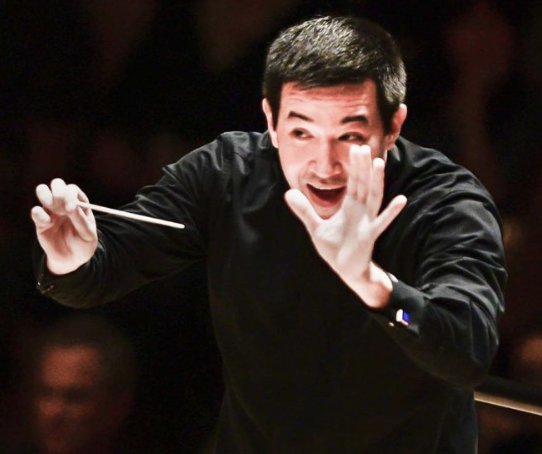|
Symphony
SRS SEASON ENDS WITH RESOUNDING TA-TA-TA-BANG
by Terry McNeill
Sunday, June 1, 2025
Symphony
YOUTHFUL VIRTUOSITY ON DISPLAY AT USO'S MAY CONCERTS
by Peter Lert
Saturday, May 17, 2025
Symphony
MYSTICAL PLANETS AND LIVELY GERSHWIN ORTIZ AT FINAL SRS CONCERT
by Peter Lert
Sunday, May 4, 2025
Symphony
VSO'S CONCERT MUSIC OF TIME, MUSIC OF PLACE
by Peter Lert
Sunday, April 27, 2025
Choral and Vocal
VOCAL ELEGANCE AND FIRE AT THE 222'S RECITAL APRIL 26
by Pamela Hicks Gailey
Saturday, April 26, 2025
CANTIAMO SONOMA SINGS AN INSPIRED GOOD FRIDAY MOZART REQUIEM CONCERT
by Pamela Hicks Gailey
Friday, April 18, 2025
DRAMATIC SHOSTAKOVICH SYMPHONY CLOSES PHILHARMONIC'S 25TH SEASON
by Terry McNeill
Sunday, April 13, 2025
LARGE COLLEGE OF MARIN AUDIENCE GREETS STOPHER ARTISTRY
by Terry McNeill
Saturday, April 5, 2025
Chamber
FRISSON DELIVERS SHIVERS OF DELIGHT
by Abby Wasserman
Sunday, March 30, 2025
OLD AND MOSTLY NEW IN SRS MARCH CONCERT IN WEILL
by Peter Lert
Saturday, March 22, 2025
|
 |
 Conductor Francesco Lecce-Chong |
SANTA ROSA SYMPHONY PREMIERES DAUGHERTY SKETCHES OF SONOMA COUNTY
by Steve Osborn
Sunday, May 8, 2022
“The most sacred duty of audiences,” said Santa Rosa Symphony Conductor Francesco Lecce-Chong at their May 8 concert, “is to hear orchestral works for the first time.” The concert offered that duty in the form of a world premiere of Michael Daugherty’s “Valley of the Moon,” a programmatic work sketching specific landscapes in Sonoma County. In the words of Daugherty, who introduced the work, “Santa Rosa, this is your piece.”
Mr. Daugherty called the four movements of “Valley of the Moon” a road trip to four spots in Sonoma County: the coast, Bodega Bay, the redwoods and Jack London State Park. All four spots are well on the beaten path, a classic itinerary for tourists.
The coastal sketch, titled “Out of the Fog,” opened with a plangent oboe solo evoking the spreading fog, followed by a French horn motif signifying a gradual lifting. These solos transpired on a lush background featuring two sweeping harps and shimmering strings. A blazing trumpet appeared to mark the entrance of the sun, followed by rolling timpani and bustling strings who dropped out one by one until only the concertmaster was left, a quiescent ending to a slow-moving event.
Bodega Bay’s claim to fame is Alfred Hitchcock’s “The Birds,” a fact that the composer recognized in his title for the town’s sketch: “Shadow of the Birds.” The movie doesn’t have incidental background music, so “Shadow of the Birds” could serve as the missing score. The sketch began with an insistent rhythm from a marimba, followed by flocks of strings swooping down like birds. An intricate polyphony between the string sections and the marimba propelled the movement forward. At times, the frenzied playing verged on the athletic, with the players a blur of motion.
Redwoods rise not far from Bodega Bay, living for hundreds of years in ancient groves. Daugherty evoked their age in the third sketch by quoting from Bach’s “Air on a G String,” which explains the “Air on the Redwoods” title. A flowing rhythm suggested the passage of time, marked by gently descending snippets from Bach’s famous Air.
In contrast, the Jack London movement, titled “Call of the Wild,” was forever on the ascent. It opened with a brisk four-note motif (call-of-the-wild) that began in the French horns and passed rapidly through the other orchestral sections. Listeners began to feel like they were going somewhere, but their progress was suddenly halted by portentous full stops and a sense of foreboding. Ghostly sounds emerged from the violins as the orchestra began a long build toward the end, getting louder and faster until they exploded in an ear-splitting final chord. The playing and conducting were stupendous, as they were throughout the concert.
In recent years, the Symphony has set a high standard that it keeps exceeding. A case in point is the work that preceded “Valley of the Moon”: Debussy’s “Prelude to the Afternoon of a Faun.”
The opening solo from flutist Kathleen Lane Reynolds was magical, transporting her listeners into the realm of myth. The melody passed seamlessly to her colleagues in the wind section, each as good as the last. Meanwhile Mr. Lecce-Chong’s minute and specific conducting gestures prompted a splendid orchestral balance. The music seemed to float on top of the air, and any forward momentum was incidental. A long pause at the end led to an appreciative “Ahhh” from the audience.
The first half was just as good, particularly Finnish violin soloist Elina Vähälä, who offered an impassioned performance of the Korngold Violin Concerto. Clad in a floor-length, bare-shouldered, flowing blue gown, Ms. Vähälä produced a consistently gorgeous and piercing tone, making herself easily heard above the orchestra. She played mostly without score but occasionally peeked at a foot-powered tablet on a nearby stand. Her bow arm moved like a ballerina’s, and her bow traversed the strings in an invariably straight line. Her stance was both solid and relaxed, and she often leaned back to emphasize important notes. Little wonder that the audience applauded warmly at the end of the first movement, before she had displayed her talents in full.
The Korngold concerto is certainly neo-Romantic, but it never descends into schmaltz. The unpredictable melodies keep it interesting, and the emotional content is sincere. In the hands of soloists like Vähälä, one can understand why it has crept back into the standard repertoire.
Speaking of standard repertoire, the opening performance of Strauss’s overture to “Die Fledermaus” was a sheer delight. Both players and conductor seemed to enjoy it immensely, and their enthusiasm was infectious.
Reprinted by permission from San Francisco Classical Voice
|

